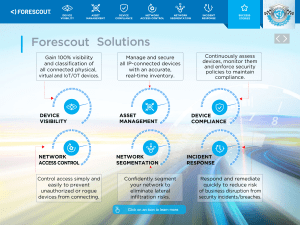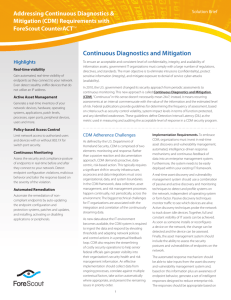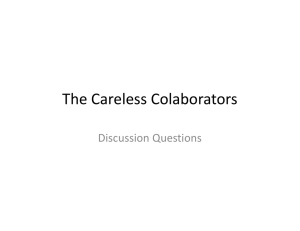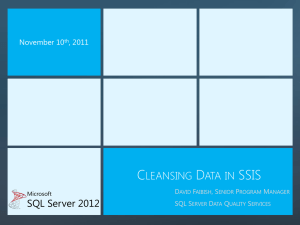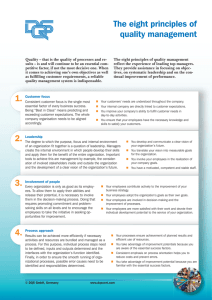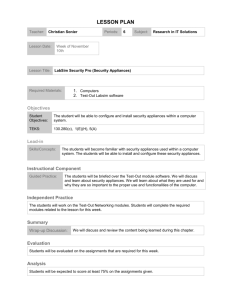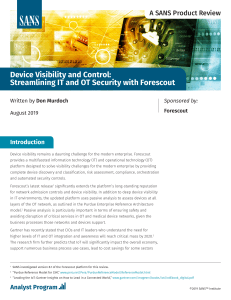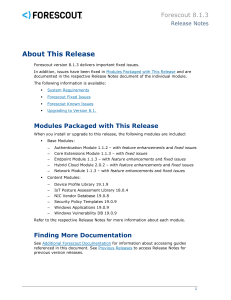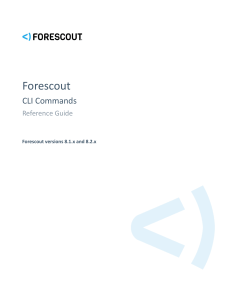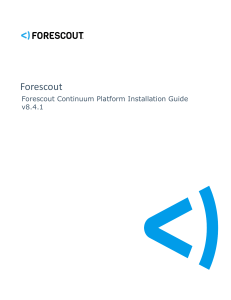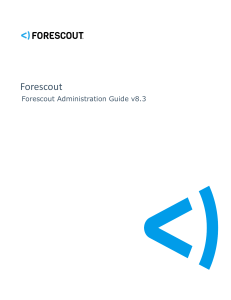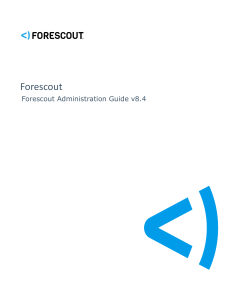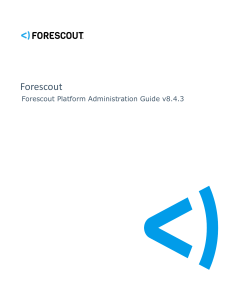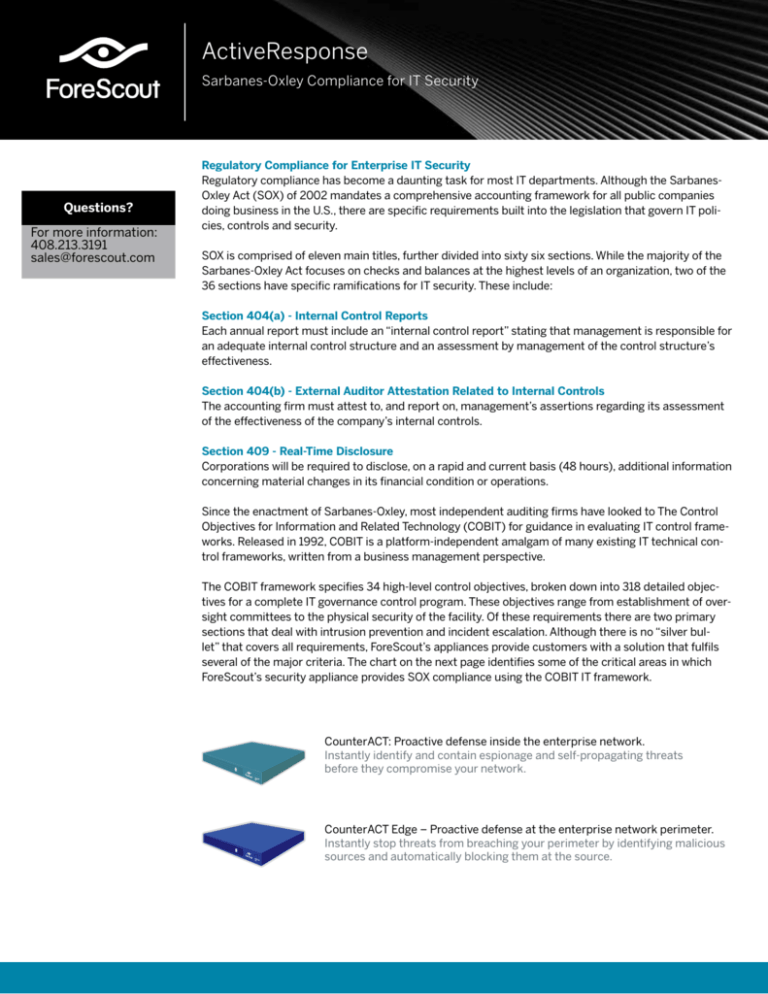
ActiveResponse
Sarbanes-Oxley Compliance for IT Security
Questions?
For more information:
408.213.3191
sales@forescout.com
Regulatory Compliance for Enterprise IT Security
Regulatory compliance has become a daunting task for most IT departments. Although the SarbanesOxley Act (SOX) of 2002 mandates a comprehensive accounting framework for all public companies
doing business in the U.S., there are specific requirements built into the legislation that govern IT policies, controls and security.
SOX is comprised of eleven main titles, further divided into sixty six sections. While the majority of the
Sarbanes-Oxley Act focuses on checks and balances at the highest levels of an organization, two of the
36 sections have specific ramifications for IT security. These include:
Section 404(a) - Internal Control Reports
Each annual report must include an “internal control report” stating that management is responsible for
an adequate internal control structure and an assessment by management of the control structure’s
effectiveness.
Section 404(b) - External Auditor Attestation Related to Internal Controls
The accounting firm must attest to, and report on, management’s assertions regarding its assessment
of the effectiveness of the company’s internal controls.
Section 409 - Real-Time Disclosure
Corporations will be required to disclose, on a rapid and current basis (48 hours), additional information
concerning material changes in its financial condition or operations.
Since the enactment of Sarbanes-Oxley, most independent auditing firms have looked to The Control
Objectives for Information and Related Technology (COBIT) for guidance in evaluating IT control frameworks. Released in 1992, COBIT is a platform-independent amalgam of many existing IT technical control frameworks, written from a business management perspective.
The COBIT framework specifies 34 high-level control objectives, broken down into 318 detailed objectives for a complete IT governance control program. These objectives range from establishment of oversight committees to the physical security of the facility. Of these requirements there are two primary
sections that deal with intrusion prevention and incident escalation. Although there is no “silver bullet” that covers all requirements, ForeScout’s appliances provide customers with a solution that fulfils
several of the major criteria. The chart on the next page identifies some of the critical areas in which
ForeScout’s security appliance provides SOX compliance using the COBIT IT framework.
CounterACT: Proactive defense inside the enterprise network.
Instantly identify and contain espionage and self-propagating threats
before they compromise your network.
CounterACT Edge – Proactive defense at the enterprise network perimeter.
Instantly stop threats from breaching your perimeter by identifying malicious
sources and automatically blocking them at the source.
COBIT DS5 – Ensure Systems Security
DS5.2 – Identification,
Authentication, and Access
The logical access to and use of IT computing resources should be restricted by
the implementation of adequate identification, authentication and authorization
mechanisms, linking users and resources with access rules. Such mechanisms
should prevent unauthorized personnel, dial-up connections and other system
(network) entry ports from accessing computer resources and minimize the
need for authorized users to use multiple logins. Procedures should also be in
place to keep authentication and access mechanisms effective (e.g., regular
password changes).
In addition to typical authentication,
ForeScout’s CounterACT 5.0 Active
Network Integrity module provides policy
based network access based upon pre
defined security criteria.
DS5.6 – User Control of User
Accounts
Users should systematically control the activity of their proper account(s). Also,
information mechanisms should be in place to allow them to oversee normal
activity as well as to be alerted to unusual activity in a timely manner.
ForeScout appliances monitor data
traffic and blocks/quarantines malicious
activity. Notification of security event is
immediate.
DS5.7 – Security Surveillance
IT security administration should ensure that security activity is logged and any
indication of imminent security violation is reported immediately to all who may
be concerned, internally and externally, and is acted upon in a timely manner.
ForeScout appliances retain a detailed
log of malicious traffic as well as security
policy violations.
DS5.9 – Central Identification
and Access Rights
Management
Controls are in place to ensure that the identification and access rights of users
as well as the identity of system and data ownership are established and managed in a unique and central manner to obtain consistency and efficiency of
global access control.
ForeScout’s CounterACT 5.0 Network
Information Portal provides a search
engine capable of correlating information
on network resources.
DS5.10 – Violation and Security Activity Reports
IT security administration should ensure that violation and security activity is
logged, reported, reviewed and appropriately escalated on a regular basis to
identify, and resolve incidents involving unauthorized activity. The logical access
to the computer resources accountability information (security and other logs)
should be granted based upon the principle of least privilege, or need-to know.
ForeScout appliances retain a detailed
log of malicious traffic as well as security
policy violations. Reports can be generated detailing all security violations.
DS5.11 – Incident Handling
Management should establish a computer security incident handling capability
to address security incidents by providing a centralized platform with sufficient
expertise and equipped with rapid and secure communication facilities. Incident
management responsibilities and procedures should be established to ensure
an appropriate, effective, and timely response to security incidents.
In addition to organizational processes,
ForeScout appliances can automate security event (malicious code, espionage,
or policy violation) escalation through
integration with trouble ticketing system.
DS5.17 – Protection of Security Functions
All security related hardware and software should at all times be protected
against tampering to maintain their integrity and against disclosure of secret
keys. In addition, organizations should keep a low profile about their security
design, but should not base their security on the design being secret.
ForeScout appliances are hardened and
secured with the most advanced security
and encryption technologies
DS5.19 – Malicious Software
Prevention, Detection, and
Correction
Regarding malicious software, such as computer viruses or Trojan horses, management should establish a framework of adequate preventative, detective, and
corrective control measures, and occurrence response and reporting. Business
and IT management should ensure that procedures are established across the
organization to protect information systems and technology from computer
viruses. Procedures should incorporate virus protection, detection, occurrence
response, and reporting.
ForeScout’s patented ActiveResponse
technology uses a deterministic approach
to accurately and automatically identify
and block self propagating malware BEFORE it penetrates the network.
DS5.20 – Firewall Architectures and Connections with
Public
Networks
If connection to the Internet or other public networks exists, adequate firewalls
should be operative to protect against denial of services and any unauthorized
access to the internal resources; should control any application and infrastructure management flows in both directions; and should protect against denial of
service attacks.
ForeScout appliances augment existing firewall technologies by enabling
real-time dynamic blocking of known and
unknown threats.
COBIT DS10 – Manage Problems And Incidents
DS10.2 – Problem Escalation
IT management should define and implement problem escalation procedures to
ensure that identified problems are solved in the most efficient way on a timely
basis. These procedures should ensure that these priorities are appropriately
set. The procedures should also document the escalation process for the activation of the IT continuity plan.
ForeScout appliances can automate security event (malicious code, espionage,
or policy violation) escalation through
integration with trouble ticketing system.
DS10.3 – Problem Tracking
and Audit Trail
The problem management system should provide for adequate audit trail facilities that allow tracing from incident to underlying cause (e.g., package release
or urgent change implementation) and back. It should work closely with change
management, availability management, and configuration management.
ForeScout captures all data related to
the security event. Data can be easily
exported for forensics and auditing.
10001 N. De Anza Boulevard, Suite 220 . Cupertino, CA 95014
Tel: 1.866.377.8771 . Fax: 1.408.213.2283 . www.forescout.com
© 2008 ForeScout Technologies, Inc. Products protected by US Patent #6,363,489, March 2002.
All rights reserved. ForeScout Technologies, the ForeScout logo, CounterACT, CounterACT Edge and
Active Response are trademarks of ForeScout Technologies, Inc. All other trademarks are the property
of their respective owners. CAvSym-1108

